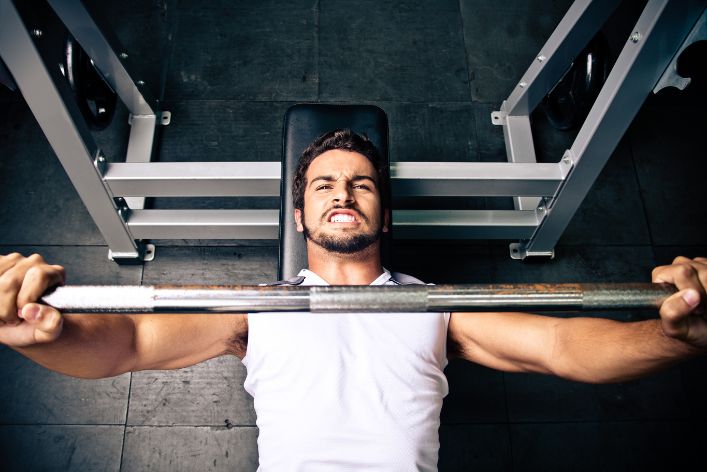There’s a good likelihood that the bench press was the exercise you concentrated on when you started working out.
Possibly even before the squat or deadlift.
For competitions, if you’re a powerlifter, it’s crucial.
The bench press is still a valuable tool for improving overall upper body strength in weightlifters and strongmen.
You can develop many upper body muscles using bench press.
You can perform this exercise with either a barbell or dumbbell.
Frequently perform them for greater strength and muscle growth as part of an upper-body workout.
But to achieve all this, it must be done well!
How to Do a Bench Press
Compound exercises like the bench press work the pectoralis major, deltoids, triceps, and upper arms.
It can help athletes improve their balance while improving their strength and size.
Various bench press variations use various pectoralis major segments and angles to provide a well-rounded aesthetic, strength, posture, and training instruments.
Although you can do this at home, it’s best at the gym.
You can use a regular flat bench instead of a bench press rack if you don’t have access to one.
Bench presses can also be performed using dumbbells or a barbell.
Whichever option you pick, choose the right weight for you.
Lie on the seat just beneath the bar-holding rack.
Your eyes should be approximately in line with the uprights of the barbell rack.
Also, your neutral spine must be flat on the bench, as are your butt, shoulders, and head.
Your feet are flat on the ground and spaced rather widely.
Use weight plates or blocks beneath your feet if your feet are not level on the floor.
This will increase stability instead of putting your legs on the bench, which will decrease it.
Steps to Follow
- Avoid pressing with your shoulders rounded by pulling your shoulder blades back behind you.
- Use an overhand grip to hold the barbell, keeping your thumbs outside of your closed fist. Your upper arms are positioned such that they are roughly shoulder-width apart and at a 45-degree angle to your body.
- Elbows locked, remove the barbell off the rack. (Avoid bringing the bar straight from the rack to the chest position.)
- As you bring the bar down to your chest, at the nipple line, take a breath.
- Breathe out as you raise your arms and press the bar towards your chest. Concentrate on the ceiling rather than the bar.
- The bar should be lowered till it is slightly over your chest. For the next bench press, this is the beginning position.
Once you’ve completed the number of reps you wanted, lock out your elbows and set the bar on the rack.
Once you can feel the uprights of the rack, slowly move the bar backwards and lower it to the barbell rest.
Avoid attempting to strike the rack rests directly.
Missing puts you at risk of losing control, which is hazardous.
Read: Why is Good Posture Crucial for Better Health?

All the Muscles a Bench Press Works
These muscles all receive an incredible workout while you perform a bench press.
It’s not just an arm exercise.
1. Pectoralis Major
The pectoralis major and minor, or “pecs,” are the chest muscles the bench press works.
These muscles are involved in the “pushing” motion that pushes the weight back to the starting position from your chest against gravity.
As you perform the move, you’ll feel your pecs tighten.
At the peak of the action, you should feel the tightest squeeze.
Yet, when you start to press the bar back up, they will exert the most effort.
2. Anterior Deltoids
Additionally, the tiny muscles on the front of your shoulders that support forward arm movement are being worked.
These are known as anterior deltoids.
Put Your Tech Company on the Map!
Get featured on Nicholas Idoko’s Blog for just $50. Showcase your business, boost credibility, and reach a growing audience eager for tech solutions.
Publish NowThey help with the pushing motion.
3. Triceps
The triceps contract all the way through the bench press.
As you get close to the top, your triceps take over to complete the motion and lock the weight out.
The muscles on the back of your arm used in all pushing activities are those mentioned above.
4. Latissimus Dorsi
The latissimus dorsi, often known as the lats, in your back, will begin to contract as the weight is brought back down.
This helps the bar or dumbbells to slow down.
For this reason, the bench press is regarded as a compound workout.
The lats, core, and biceps may not be physically worked out by them.
But the work out activates all of these muscles to keep you steady as you perform the activity.
5. Serratus Anterior Muscle
You’ll also work out the serratus anterior muscles, which are on the sides of your chest and on your ribs.
During pressing and pushing workouts, the serratus anterior supports your shoulder girdle.
Your rotator cuff is less stressed, enabling you to carry heavier weights.
Read: How to Choose the Right Workout for Your Lifestyle
Other Variations of the Bench Press
Partial Bench Press
Once you have some bench press experience, you can change the grip to target slightly different muscle groups.
For example, a slightly wider grasp will make the pectorals more active, whereas a tighter grip will make the triceps more active.
Incline bench press
You can execute this press while seated on an inclined bench.
The upper chest of the shoulder, or the anterior deltoids, is highlighted while lifting from an incline.
An incline press can be performed using dumbbells or a barbell.
The bench should be tilted upward between 45 and 60 degrees for this variant so that you are leaning back slightly and placing your weight just above your chest.
To return to the beginning position, slowly drop the weight after pressing it up toward the ceiling.
Decline bench press
Another choice is to carry out this exercise on a decline bench, which highlights the pectoralis major more clearly.
You perform a decline bench press in the same manner as a regular bench press, just from a squatted position.
The bench should be sloped downward so that your feet are higher than your head.
It exercises the shoulders and lower chest muscles.

Narrow grip bench press
In this version, your hands are closer together on the barbell, and you press it essentially the same way you would during a bench press.
It strengthens the forearms and triceps.
All of these variants don’t have to be performed in the same workout.
You can injure a muscle group from overusing it.
This is especially true if you’re using hefty objects to lift.
You can choose two or more options for each workout if you prefer diversity.
Give yourself one or two days off to allow your muscles to recuperate before attempting the other versions.
In addition to being wanted by bodybuilders, muscle growth has advantages for everyone because muscle mass normally declines with age.
The bench press is a useful workout that makes it easier to push or move things around in your daily life.
For athletes who predominantly employ pulling muscles, the bench press can aid in regaining muscle balance.
This comprises swimmers, wrestlers, and rock climbers.
Put Your Tech Company on the Map!
Get featured on Nicholas Idoko’s Blog for just $50. Showcase your business, boost credibility, and reach a growing audience eager for tech solutions.
Publish NowAlong with the deadlift and squat, the barbell bench press is a competitive lift in powerlifting.
Read: 7 Reasons Why You Should Go to the Gym
Conclusion
In conclusion, the bench press is essential for building upper body strength and muscle mass.
It targets multiple muscle groups, including the pectorals, deltoids, triceps, and lats, making it a comprehensive workout.
With various bench press variations like incline, decline, and narrow grip, you can tailor your routine to target specific areas.
Whether you’re a powerlifter, athlete, or fitness enthusiast, incorporating the bench press into your workout can enhance your strength, improve muscle balance, and support overall fitness goals.
Just remember to practice proper form and give your muscles time to recover for optimal results.
Before You Go…
Hey, thank you for reading this blog post to the end. I hope it was helpful. Let me tell you a little bit about Nicholas Idoko Technologies.
We help businesses and companies build an online presence by developing web, mobile, desktop, and blockchain applications.
We also help aspiring software developers and programmers learn the skills they need to have a successful career.
Take your first step to becoming a programming expert by joining our Learn To Code academy today!
Be sure to contact us if you need more information or have any questions! We are readily available.
[E-Books for Sale]
1,500 AI Applications for Next-Level Growth: Unleash the Potential for Wealth and Innovation
$5.38 • 1,500 AI Applications • 228 pages
Are you ready to tap into the power of Artificial Intelligence without the tech jargon and endless guesswork? This definitive e-book unlocks 1,500 real-world AI strategies that can help you.
See All 1,500 AI Applications of this E-Book
750 Lucrative Business Ideas: Your Ultimate Guide to Thriving in the U.S. Market
$49 • 750 Business Ideas • 109 pages
Unlock 750 profitable business ideas to transform your future. Discover the ultimate guide for aspiring entrepreneurs today!
See All 750 Business Ideas of this E-Book
500 Cutting-Edge Tech Startup Ideas for 2024 & 2025: Innovate, Create, Dominate
$19.99 • 500 Tech Startup Ideas • 62 pages
You will get inspired with 500 innovative tech startup ideas for 2024 and 2025, complete with concise descriptions to help you kickstart your entrepreneurial journey in AI, Blockchain, IoT, Fintech, and AR/VR.
We Design & Develop Websites, Android & iOS Apps
Looking to transform your digital presence? We specialize in creating stunning websites and powerful mobile apps for Android and iOS. Let us bring your vision to life with innovative, tailored solutions!
Get Started Today



